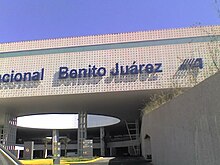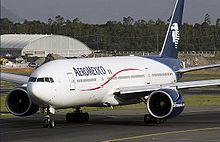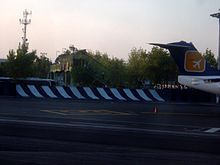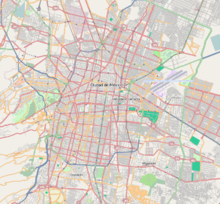Mexico City International Airport
Benito Juarez International Airport Aeropuerto Internacional de la Ciudad de México Benito Juárez | |||||||||||||||
|---|---|---|---|---|---|---|---|---|---|---|---|---|---|---|---|
| File:Aicm.jpg | |||||||||||||||
 Mexico City International Airport as seen from a satellite before the construction of Terminal 2. | |||||||||||||||
| Summary | |||||||||||||||
| Airport type | Civil | ||||||||||||||
| Owner | Grupo Aeroportuario de la Ciudad de México | ||||||||||||||
| Operator | Aeropuertos y Servicios Auxiliares | ||||||||||||||
| Serves | Mexico City, Mexico | ||||||||||||||
| Location | Venustiano Carranza, D.F. | ||||||||||||||
| Hub for | |||||||||||||||
| Elevation AMSL | 7,316 ft / 2,230 m | ||||||||||||||
| Website | www | ||||||||||||||
| Map | |||||||||||||||
| Runways | |||||||||||||||
| |||||||||||||||
| Statistics (2011) | |||||||||||||||
| |||||||||||||||
Benito Juárez International Airport (Spanish: Aeropuerto Internacional de la Ciudad de México Benito Juárez or AICM), (IATA: MEX, ICAO: MMMX) in Venustiano Carranza, one of the sixteen boroughs into which Mexico's Federal District is divided, is a commercial airport that serves Mexico City, the capital of Mexico. It is Mexico's busiest airport by both passenger traffic and aircraft movements and is the Latin America's second busiest airport by passenger traffic after Guarulhos Airport in São Paulo, Brazil and the busiest airport by aircraft movements. Although Juárez was not its official name for several decades, it was formally named after the 19th century president Benito Juárez in 2006, and is Mexico's main international and domestic gateway. The airport is owned by Grupo Aeroportuario de la Ciudad de México and operated by Aeropuertos y Servicios Auxiliares, the government-owned corporation, who also operates 21 others airports through Mexico. In recent years Toluca Airport has become an alternate airport.
This hot and high airport is served by 30 domestic and international airlines and offers direct flights to more than 100 destinations worldwide.It provides non-stop services from Mexico City to North America, Central America and Caribbean, South America, Europe and Asia (Aeromexico is the only airline that flies to Asia from Mexico City). In 2011, the airport served 26,368,861 passengers a 9.28% increase compared to 2010. In optimal conditions, and with the recent renovations and expansion projects completed, the Benito Juárez airport will be able to handle up to 32 million passengers per year.[3] As the main hub for Mexico's largest airline Aeroméxico and a secondary hub for its subsidiary Aeroméxico Connect, the airport has become a SkyTeam hub. It is also a hub for Aeromar, Interjet and a focus city for VivaAerobus and Volaris.
Location
The airport is 5 km. east from central Mexico City and is surrounded by the built-up areas of Gustavo A. Madero to the north and Venustiano Carranza to the west, south and east. As the airport is east Mexico City and its runways run southwest-northeast, and airliner's landing approach is usually directly over Mexico City. Therefore, there is an important overflying problem.
History
The airport first opened as Balbuena Military Airport with five runways. The first landing was on November 5, 1928 and regular service started a year later, but was officially inaugurated on May 15, 1931. Its first international route was to Los Angeles International Airport operated by Mexicana. President Miguel Alemán opened the terminal in 1952, thus becoming a commercial airport. In the 1970s, president Luis Echeverría closed three runways and gave that land to poor people in order to build their homes, leaving just two parallel runways. In 1980, the terminal was expanded to double its capacity, using a single large terminal rather than multiple terminals as in other airports. Ten years later in 1990, the mixed domestic/international gates were separated to increase the terminal's functionality, along with the separation of domestic and international check-in halls.
In 2001, the east wing of the terminal (H-gates) was opened as a final call waiting area, mainly used by SkyTeam members. Because of the increasing traffic, president Vicente Fox announced the construction of a new, larger airport on 5,000 hectares (12,000 acres) in the municipalities of Texcoco and San Salvador Atenco, but when local violent protests aroused, the new airport was cancelled. Instead, he launched a program called Expansion of Mexico City Airport to its Maximum Capacity in 2002 to increase the airport's capacity. The whole terminal was expanded and upgraded with new check-in halls, 13 more baggage claim belts, the construction of Departures and Arrivals floors, construction of several new taxiways and a whole new terminal opposite of the original, thus breaking the single terminal concept. The project was started with an initial investment of $200,000,000 MXP. Nevertheless, its final cost was $800,000,000 MXP. The original quasi-Terminal 2, which only housed Aeromar's operations in and out the airport was demolished, and the new Terminal 2 was built in less than two years.
On November 15, 2007, Terminal 2 was opened, increasing the airport's capacity. All SkyTeam members moved their operations to the new terminal, except Air France and KLM. It was officially inaugurated on March 2008, once the new road accesses and taxiways were finished. Terminal 2 increased the airport's contact positions by 40%, and the operational capacity by 15%.
Lack of capacity and slot restriction

The airport has suffered from a lack of capacity due to restrictions for expansion, since it is located in a densely-populated area. Some analysts have reported that if the airport had grown at the same speed as demand, it would now serve over 40 million passengers annually. The main issue with the airport is the limitation that its two runways provide, since they are used at 97.3% of their maximum capacity, leaving a very short room for new operations into the airport. Only government, military, commercial and specially authorized aircraft are allowed to land at the airport. Private aircraft must use alternate airports, such as Lic. Adolfo Lopez Mateos International Airport in Toluca, General Mariano Matamoros Airport in Cuernavaca or Hermanos Serdán International Airport in Puebla. Even with the inauguration of the new Terminal 2, the airport would be ideally designed to serve around 18 million passengers per year, according to the international standards for runway and terminal usage. Instead, the airport will keep increasing the number of passengers from around 26 million passengers in 2008 at a rate of 16% per year.
The Mexican Government laid the groundwork for a new airport to be built on the outskirts of Mexico City. After decades of planning a $2.3 billion dollar airport, peasant farmers who owned the property where the airport was proposed, took several hostages into their hands, refusing to give up their land at any cost.
Terminals and facilities




Terminals
Mexico City International Airport has two passenger terminals. Terminal 1 is separated from the other by the runways.
Terminal 1
- Opened in 1958; expanded in 1970, 1989, 1998, 2000 and 2004
- Overall terminal surface: 548,000 sq meters
- Contact positions: 33
- Remote positions: 20 (34 Before New T2 was built)
- Number of jetways: 33
- Number of airside halls: 10 (A, B, C, D, E, F, G, H, I, J)
- Number of landside (check-in) halls: 9 (A1, A2, B, C, D, D1, F1, F2, F3)
- Number of mobile-lounges: 11 (A7-A, A7-B, A7-C, A9-A, A9-B, A9-C, A9-D, A9-E, F19-A, F19-C, F19-D)
- Hotel service: 600 rooms (Camino Real), 110 rooms (Hilton Mexico City)
- Parking service: 3,100 vehicles (Domestic), 2,400 vehicles (International)
- Space per passenger in T1: 17 sq meters
- Number of baggage claiming carousels: 22
- Premium Lounges in T1: Salón Premier Internacional T1 (Aeroméxico), United Club (United Airlines), Admirals Club (American Airlines), American Express Lounge (American Express).
Terminal 1 is currently the largest airport terminal in the Americas and the fourth largest in the world.
Terminal 2
- Opened in 2007
- Overall terminal surface: 242,000 sq meters
- Contact positions: 23
- Remote positions: 17 (Aeromar and Aeromexico Connect)
- Number of jetways: 23
- Number of airside halls: 2 (Domestic, International)
- Number of landside (check-in) halls: 3 (L1, L2, L3)
- Hotel service: 287 rooms (NH)
- Parking service: 3,000 vehicles
- Space per passenger in T2: 22 sq meters
- Number of baggage claiming carousels: 15
- Premium Lounges in T2: Club Diamante (Aeromar), Salón Premier (Aeroméxico), Salón Premier Internacional T2 (Aeroméxico), Riedel Wine Room (Aeroméxico), Travel Pass Elite Lounge (Banamex), Centurion American Express Lounge (American Express).
- Platform surface: 426,000 sq meters
- Inter-terminal Aerotrén capacity: 7,800 daily passengers
Terminal 2 is now housing all Aeroméxico flights out of the airport, becoming the airline's main distribution center. Although the terminal was intended to be served by all-SkyTeam member airlines, Air France and KLM decided to remain at Terminal 1.
The airport houses a wide variety of lodging options for its passengers, including hotels inside Terminal 1 (the Hilton Hotel, the Camino Real and the Fiesta Inn), as well as a NH Hotel at Terminal 2.
Other facilities
Aeropuertos y Servicios Auxiliares, a government-owned corporation that operates airports in Mexico, has its headquarters on the airport property.[4] The Aeromar headquarters are located in Hangar 7 in Zone D of the General Aviation Terminal of the airport.[5][6] Aviacsa has its headquarters in Hangar 1 in Zone C.[7]
Airlines and destinations








- Notes
- ^1 Aeromar has remote positions, just north of Terminal 2.
Other services.
In addition to the scheduled airlines above, Mexico City airport is used by some further airlines for chartered flights including:
Cargo airlines
As of May 2012, Mexico City airport is served by 17 cargo airlines flying directly to Europe, Central, North and South America. Over 411,000 metric tonnes pass through the airport in 2011, making it the third busiest by cargo traffic in Latin America, after El Dorado International Airport in Bogotá and Guarulhos International Airport in São Paulo. Most passenger airlines, such as AeroMéxico and KLM use the airport to carry hold cargo on passenger flights, though most cargo is transported by all-cargo airlines. The following airlines operate the following scheduled destinations.
Airlines providing on-demand cargo services
|
Traffic statistics
|
|
| Year | Domestic | % change | International | % change | Total | % change |
|---|---|---|---|---|---|---|
| 2012 [Jan.-March] |
20,335.64 | 79,204.46 | 99,540.10 | |||
| 2011 | 81,953.37 | 329,502.22 | 411,455.59 | |||
| 2010 | 84,846.88 | 308,228.99 | 393,075.87 | |||
| 2009 | 83,999.43 | 237,134.01 | 321,133.44 | |||
| 2008 | 97,070.08 | - | 279,025.63 | - | 376,095.71 | - |
Operations
In 2010, Benito Juárez was the busiest airport in Latin America by aircraft movements with 27.3% more operations than El Dorado International Airport in Bogotá and 35.5% more than Guarulhos Airport in São Paulo. For the 12-month period ending December 31, 2011, the airport had 350,032 aircraft operations, an average of 959 operations per day.
| Rank | Airport | Passengers | Rank change | % Change YoY |
Carriers |
|---|---|---|---|---|---|
| 1 | 738,882 | Aeroméxico, Alaska, United, Volaris | |||
| 2 | 653,012 | Aeroméxico, Aeroméxico Connect, ExpressJet Airlines, United | |||
| 3 | 632,453 | Aeroméxico, Aeroméxico Connect, American, Interjet | |||
| 4 | 550,906 | Aeroméxico, Delta, United | |||
| 5 | 479,712 | Aeroméxico, Iberia | |||
| 6 | 422,405 | Aeroméxico, Air France | |||
| 7 | 369,668 | Aeroméxico, American, United, Volaris | |||
| 8 | 361,065 | Aeroméxico, Avianca, Copa Airlines Colombia | |||
| 9 | 358,072 | American | |||
| 10 | 304,277 | Delta | |||
| 11 | 261,224 | Aeroméxico, LAN Perú, TACA Perú | |||
| 12 | 261,216 | Copa | |||
| 13 | 222,514 | Aeroméxico, TAM Airlines | |||
| 14 | 211,012 | Lufthansa | |||
| 15 | 200,970 | Aeroméxico, United | |||
| 16 | 186,636 | Aeroméxico, Volaris | |||
| 17 | 182,441 | KLM | |||
| 18 | 182,239 | Aeroméxico, Cubana, Interjet | |||
| 19 | 176,819 | Aerolíneas Argentinas, Aeroméxico | |||
| 20 | 174,861 | Aeroméxico, LAN | |||
| 21 | 164,703 | Aeroméxico, Aeroméxico Connect, TACA, Interjet | |||
| 22 | 161,652 | US Airways | |||
| 23 | 157,767 | Aeroméxico, LACSA | |||
| 24 | 143,300 | Aeroméxico, Aeroméxico Connect, Interjet | |||
| 25 | 115,167 | Air Canada |
- Notes
- ^1 Official statistics include JFK and Newark airports.
- ^2 Official statistics include Midway and O'Hare airports.
| Rank | Airport | Passengers | Rank change | % Change YoY | Carriers |
|---|---|---|---|---|---|
| 1 | 2,300,581 | Aeroméxico, Interjet, Magni, VivaAerobus, Volaris | |||
| 2 | 2,101,226 | Aeroméxico, Aeroméxico Connect, Interjet, VivaAerobus, Volaris | |||
| 3 | 1,769,366 | Aeroméxico, Aeroméxico Connect, Interjet, VivaAerobus, Volaris | |||
| 4 | 940,833 | Aeroméxico, Aeroméxico Connect, Interjet, Magni, VivaAerobus | |||
| 5 | 891,142 | Aeroméxico, Aeroméxico Connect, Interjet, Volaris | |||
| 6 | 715,608 | Aeroméxico, Aeroméxico Connect, Interjet, VivaAerobus | |||
| 7 | 647,144 | Aeroméxico, Aeroméxico Connect, Interjet, VivaAerobus | |||
| 8 | 513,182 | Aeroméxico, Interjet, Volaris | |||
| 9 | 496,209 | Aeroméxico, Aeroméxico Connect, Interjet | |||
| 10 | 454,106 | Aeroméxico, Aeroméxico Connect, Interjet, Volaris | |||
| 11 | 417,239 | Aeroméxico, Aeroméxico Connect, Interjet, Volaris | |||
| 12 | 402,802 | Aeromar, Aeroméxico Connect, Interjet, VivaAerobus | |||
| 13 | 385,888 | Aeroméxico, Aeroméxico Connect, Interjet, Magni, Volaris | |||
| 14 | 380,399 | Aeromar, Aeroméxico Connect, Interjet, Magni, VivaAerobus | |||
| 15 | 379,296 | Aeroméxico, Aeroméxico Connect, Interjet, Magni | |||
| 16 | 356,979 | Aeroméxico, Aeroméxico Connect, Interjet, VivaAerobus | |||
| 17 | 295,216 | Aeromar, AeroMéxico, Aeroméxico Connect, Interjet | |||
| 18 | 270,595 | Aeroméxico, Aeroméxico Connect, VivaAerobus | |||
| 19 | 265,107 | Aeroméxico, Aeroméxico Connect, VivaAerobus | |||
| 20 | 233,170 | Aeroméxico, Aeroméxico Connect, Interjet | |||
| 21 | 227,813 | Aeroméxico, Aeroméxico Connect, Volaris | |||
| 22 | 218,424 | Aeroméxico Connect | |||
| 23 | 215,143 | Aeromar, Aeroméxico Connect, Interjet, Magni | |||
| 24 | 196,892 | Aeroméxico Connect, VivaAerobus | |||
| 25 | 187,903 | Aeroméxico Connect, Volaris |
|
|
Inter-terminal transportation

Terminal 2 is connected to Terminal 1 by the Aerotrén monorail system in which only connecting passengers with hand baggage are allowed to use with their boarding pass. Technical and cabin crew can also use it. Normal operation hours are from 5:00 am to 11:00 pm, every day of the year, and the first run always begins from T2 to T1; the last run of the day is to T2. The distance between the terminals is 3 km. and the Airtrain's speed is 45 km. per hour. The Airtrain journey, once the doors are fully closed therefore takes approximately 4 minutes and 40 seconds between stations in both directions. Also, if you arrive as a train is leaving the maximum waiting period for the next train is 11 minutes. Also there is a land service between terminals called "inter-terminal transportation". These buses are located at entrance no. 6 of Terminal 1 and entrance no. 4 of Terminal 2.
Ground transportation

The airport is served by the Terminal Aérea Metro station, which belongs to Line 5 of the subway, running from File:Metro pantitlan.png Pantitlán station to File:Metro politecnico.png Politécnico station. It is located just outside the T1's national terminal.Terminals 1 and 2 have two land terminals operating 24 hours a day, 365 days a year. Different bus lines operate from here [2], and provide continuous transportation services to the main cities located around Mexico City, such as Córdoba, Cuernavaca, Pachuca, Puebla, Querétaro, Tlaxcala and Toluca. The Terminal 1 land terminal is located in front of the international area vehicular ramp and its facilities include various services for the comfort of the passengers. Among others, it offers VIP lounges, internet, resting, reading and meeting halls. The Terminal 2 land terminal is located at gate D, between entrance 4 and the national arrival passenger exit, and its facilities include resting halls and a fast food area.
In late 2010, Head of Government of the Federal District Marcelo Ebrard announced a plan to build a new Metrobús Line 4 that would run from near Buenavista Station in the west of the city towards Mexico City airport. Construction on Line 4 started on July 4, 2011. The plans for Line 4 include a two step construction process with the first 28 kilometres (17 mi) operational segment to be built between Buenavista and Metro San Lázaro. A later extension would provide travel between San Lázaro and the Airport. The line opened on April 1, 2012.
| Service | Destinations [departing from the airport] | Operator |
|---|---|---|
| Metro San Lázaro, TAPO bus station, Historic Centre, Metro Buenavista, Buenavista Station | Metrobus, a government-owned corporation. |
Authorized taxis
Taxis are in operation in Terminals 1 and 2 and there are two models of service: Ordinary service in a sedan type vehicle for 4 passengers. Executive service in 8 passengers vans. At present there are 5 taxi groups in operation. These are the only taxis authorized by the Ministry of Communications and Transport (SCT) of the Federal Government. The Terminal 1 taxi boarding areas are located at entrances 1 and 10; and in Terminal 2, boarding areas are located at entrances 3 and 4. Taxi rates are registered under the SCT and include passenger insurance, civil liability and medical expenses for all occupants. To receive the taxi service you must purchase the corresponding ticket previously at the authorized sale points located within the airport.
Parking
T1 National parking lot is located on Av. Capitán Carlos León in front of entrances 1 and 2 of the terminal building, in the national arrivals zone. It has the capacity of 1,971 vehicles which are permanently monitored by a modern security and surveillance system, by way of closed circuit TV cameras. T1 International parking lot is located on Av. Capitán Carlos León in front of the international area of the terminal building, on one side of the long-distance bus terminal. It has a capacity of 2,106 vehicles. An additional parking option for Terminal 1 airport users is Parking Lot 06, located on Sonora street in front of the taxi rank. Because of its location, it is a useful alternative for those visiting the airport customs, loading area, customs agencies and some airline offices. The new AICM Terminal 2 parking lot is located on one side of the Terminal's great central patio. It has the capacity of 2,437 vehicles.
Accidents and incidents
- On 10 April 1968, Douglas R4D-3 XA-GEV of Aerovías Rojas crashed on approach, killing all eighteen people on board. The aircraft was operating a domestic scheduled passenger flight, which was the airline's inaugural flight from Aguascalientes International Airport to Mexico City.[11]
- On October 31, 1979, Western Airlines Flight 2605 crash-landed. The crew of the DC-10 had landed on the wrong runway and the jetliner hit construction vehicles that were on the closed runway. There were 78 fatalities (including one on the ground) and 14 survivors.
- An Aero California DC-9-15 overran in 2006, during an intense storm at the airport. There were no victims, but the aircraft was scrapped. However, a woman died later due to a heart attack.[citation needed]
- On September 9, 2009, hijacked Aeroméxico Flight 576 landed at Mexico City International Airport from Cancun International Airport.
- On September 13, 2009, Lufthansa Cargo McDonnell-Douglas MD-11 D-ALCO was damaged in a heavy landing. Post landing inspection revealed that there were wrinkles in the fuselage skin and the nose gear was bent.[12] According to a Lufthansa spokesman, the aircraft will be repaired and returned into full service.[13]
See also
- List of the busiest airports in Mexico
- List of airports in Mexico
- Transportation in Mexico
- Transportation in Mexico City
References
- ^ Template:WAD
- ^ Airport information for MEX at Great Circle Mapper. Source: DAFIF (effective October 2006).
- ^ "BEGIN SERVICE IN THE AICM T2: Aeromexico, Aeromexico Connect, COPA & LAN (In Spanish)". Mexico City International Airport. Retrieved January 25, 2010.
- ^ "Home." Aeropuertos y Servicios Auxiliares. Retrieved on December 20, 2010. "Av.602 No.161 Col.Zona Federal Aeropuerto Internacional Ciudad de México Delegación Venustiano Carranza, C.P.15620, México D.F."
- ^ "Directory: World Airlines." Flight International. March 16–22, 2004. 50. "Hangar 7, Zona "D", Terminal de Aviacion General, Col Federal, Mexico DF, 15620, Mexico"
- ^ "DIRECTORIO DE OFICINAS DE VENTAS." Aeromar. August 16, 2007. 3/7. "CORPORATIVO MEXICO Hangar No. 1 Zona "D" Col. Federal 15620 México, D. F."
- ^ "Directorio." Aviacsa. Retrieved on January 23, 2011. "DIRECCIÓN COMERCIAL Hangar 1, Zona "C", Col. Aviación Gral. [...] Aeropuerto Int. de la Cd. de México. C.P. 15520"
- ^ [1], BlogSouthwest, December 5, 2011, Retrieved 2011-12-05
- ^ "Statistics Mexico City Airport". Mexico City International Airport. Retrieved January 25, 2010.
- ^ http://www.sct.gob.mx/transporte-y-medicina-preventiva/aeronautica-civil/estadistica/
- ^ "XA-GEV Accident description". Aviation Safety Network. Retrieved 24 July 2011.
- ^ "Accident: Lufthansa Cargo MD11 at Mexico City on Sep 13th 2009, hard landing". The Aviation Herald. Retrieved 11 October 2009.
- ^ "Lufthansa Cargo wird D-ALCO in Stand setzen". aero.de/Aviation Media & IT. Retrieved 24 October 2009.Template:De icon
External links
- Mexico City International Airport (Menu)
- Aeropuertos y Servicios Auxiliares Homepage Template:Es icon
- New Terminal 2 Video Template:Es icon
- Information about Mexico City Airport
- Taxis Nueva Imagen Mexico City Airport taxis.
- Accident history for MEX at Aviation Safety Network
Gallery
<gallery> Image:Mexicana A320-231 StarAlliance at MMMX.jpg|A Mexicana A320 specially painted in Star Alliance livery to commemorate the airline's membership. [2003] Image:Aeromexico Boeing.jpg|An AeroMexico Boeing 757-200 at T1 before the construction of Terminal 2. [2005] Image:Mexicana A320 standing in mexico airport.jpg|A Mexicana Airbus 320 parked at T1. [2006] Image:AM Embraer ERJ-190 MEX DIC 2007.jpg|An AeroMexico Connect Embraer 190 taxiing. [2007] Image:B767 MXA.JPG|A Mexicana Boeing 767 is taking off on runway 05L. [2008] Image:A320 MX MEX.JPG|A Mexicana A320 landing on runway 05 Left. [2008] Image:Mexicana Airbus A318 AADPR.jpg|Mexicana Airbus A318. [2010]

